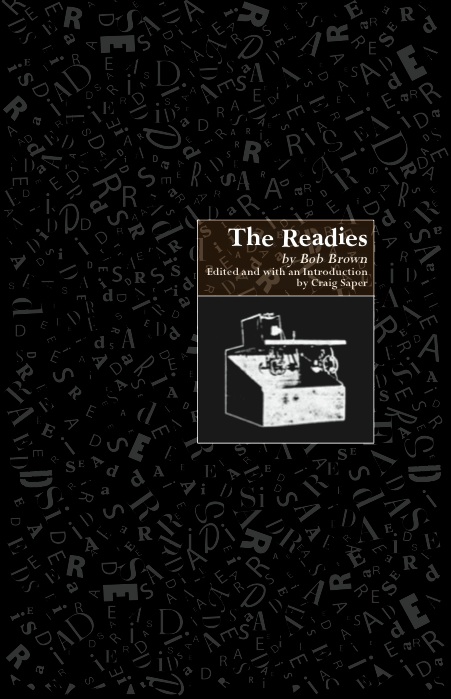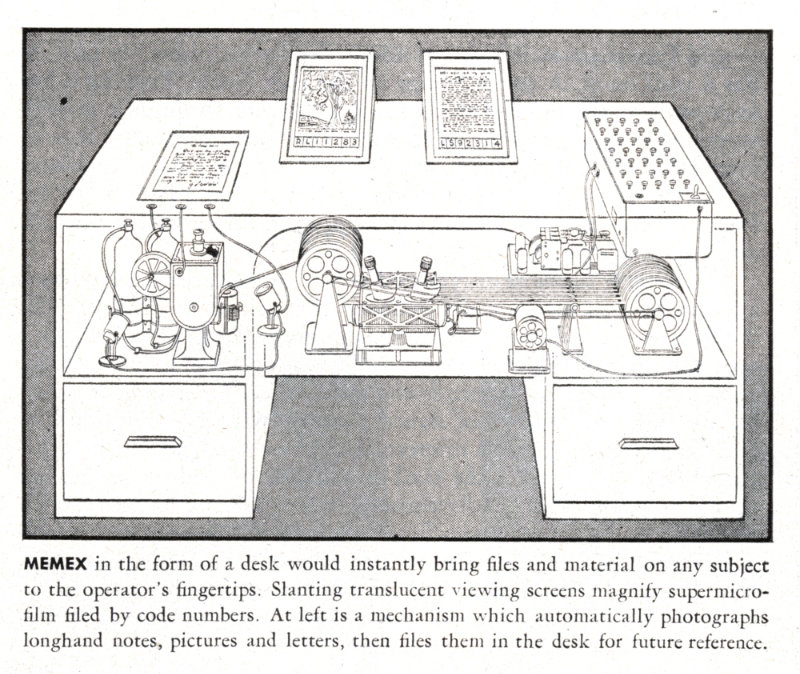Bob Brown: The Readies (1930/2014)
Filed under book | Tags: · book, machine, reading, text

“In 1930, Bob Brown predicted that the printed book was bound for obsolescence. The time has come, he insisted, to rid the reader of the cumbersome book. He invented a machine that would allow one to read books and any text extremely fast and in a hyper abbreviated form. He called these abbreviated texts, with em dashes replacing words: readies. He envisioned sending the condensed texts through wireless networks. The Readies, describes these eponymously named abbreviated texts and his plans for a reading machine, but since he printed only 150 copies, the volume is practically unknown outside of a small circle of scholars. With this new edition, Craig Saper hopes to introduce Bob Brown’s Roving Eye Press books to a new generation of readers.”
First published in 1930
Edited and with an Introduction by Craig Saper
Publisher Roving Eye Press, 2014
ISBN 9780692217238
xxxvi, 52 pages
via Kwisniewski
Readies.org, Related essay by Craig Saper (2011)
An essay by Abigail Thomas (2012, at P-DPA)
Publisher (provides free download)
PDF (13 MB)
Comment (0)James Nyce, Paul Kahn (eds.): From Memex to Hypertext: Vannevar Bush and the Mind’s Machine (1991)
Filed under book | Tags: · book, computing, history of computing, history of technology, hypertext, reading, technology, writing
“Vannevar Bush, the engineer who designed the world’s most powerful analog computer, envisioned the development of a new kind of computing machine he called Memex. For many computer and information scientists, Bush’s Memex has been the prototype for a machine to help people think.
This volume, which the editors have divided into sections on the creation, extension, and legacy of the Memex, combines seven essays by Bush with eleven others by others that set his ideas within a variety of contexts. The essays by Bush range chronologically from the early “The Inscrutable Thirties” (1933), “Memorandum Regarding Memex” (1941), and “As We May Think” (1945), to “Memex II” (1959), “Science Pauses” (1967), “Memex Revisited” (1967), and a passage from “Of Inventions and Inventors” (1970). Bush’s essays are surrounded by four chapters that place his changing plans for the Memex within his career and within information technology before digital computing.”
Contributors include Larry Owens, Colin Burke, Douglas C. Engelbart, Theodor H. Nelson, Linda C. Smith, Norman Meyrowitz, Tim Oren, Gregory Crane, and Randall H. Trigg.
Publisher Academic Press, San Diego and London, 1991
ISBN 0125232705, 9780125232708
367 pages
via Marcell Mars, in the Unlimited Edition
Memex animation (1995)
Review (George P. Landow, The Journal of Computing in Higher Education, 1992)
Review (Matthew Wall, College & Research Libraries, 1992)
Review (Liam Murray, ReCALL, 1993)
Astrid Lorange: How Reading is Written: a brief index to Gertrude Stein (2012)
Filed under thesis | Tags: · literary theory, literature, poetics, poetry, reading, text, writing
This thesis grows out of a set of interlinked questions to do with reading Gertrude Stein: in particular, how to account for the experience of reading a body of work that is largely resistant to conventional and interpretation-based models of literary criticism. What is being read? What is an effective and explanatory way of writing about the reading experience of a Steinian text? And finally, what constitutes a contemporary critical judgment in relation to an experimental poetics such as Stein’s?
For the one who reads Stein, the question of what is being read is a complex one. If Stein is not writing representationally, then there is no singular meaning to be interpreted. Stein, however, is not writing non-representational poetry as a project in itself. Thus, to read Stein’s work exclusively as a meditation on the plurality of meaning makes for a limited discussion of her poetics. Stein did not regard writing to be a representational or metaphorical process: she regarded it as an aspect of experience and a form of thinking. This study argues that Stein’s work elicits a reading approach that is productive of knowledge.
The thesis seeks to answer the question of how to find a way of writing about the reading of Stein by proposing a series of traverses across selective instances, rather than by engaging interpretative textual methods. These trains of thought are inclusive; they are not necessarily congruent or parallel with each other. It is, rather, a grouping of inter-related concerns. The thesis proposes that a network of understandings can accordingly capture something of the non-normative nature of Stein’s writing as well as the multifarious activities of knowing, unknowing, speaking, eating, resembling, noticing, playing, dancing, walking, forgetting, collecting, teasing, joking, proposing, and writing which, among others, constitute Stein’s oeuvre.
Lastly, and in relation to the final question, this thesis attempts a critical response to the reading of Stein. If reading Stein occasions thinking, then the present study is a record of a reader’s account, as well as a theory of reading. The thesis is structurally and conceptually an index to Stein’s poetics. It reads Stein alongside writers and thinkers across discourses of philosophy, science, queer theory, and literary criticism. In particular, it reads with Alfred North Whitehead, William James, Gilles Deleuze, Félix Guattari, Karen Barad, Daniel Tiffany, and Sianne Ngai. It aims to construct an intellectual episteme for Stein’s work—one that connects with contemporary contexts as well as repositioning Stein in her moment of transnational modernism.
Doctor of Philosophy
Faculty of Arts and Social Sciences, University of Technology, Sydney, 2012
212 pages
Publisher
Forthcoming as a book (November 2014)
PDF (an unedited version, different from the one to appear as a book)
Comments (3)

